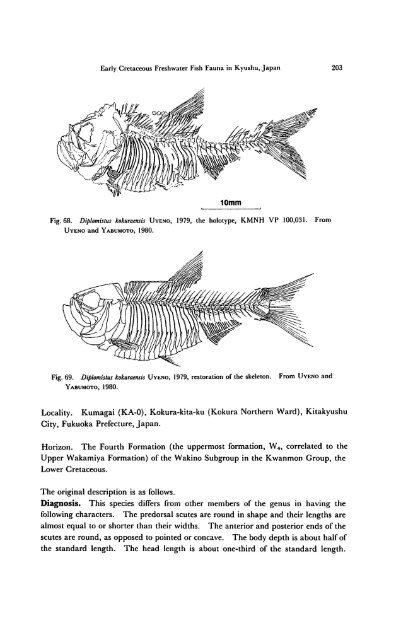Early Cretaceous Freshwater Fish Fauna in Kyushu, Japan
Early Cretaceous Freshwater Fish Fauna in Kyushu, Japan
Early Cretaceous Freshwater Fish Fauna in Kyushu, Japan
Create successful ePaper yourself
Turn your PDF publications into a flip-book with our unique Google optimized e-Paper software.
<strong>Early</strong> <strong>Cretaceous</strong> <strong>Freshwater</strong> <strong>Fish</strong> <strong>Fauna</strong> <strong>in</strong> <strong>Kyushu</strong>, <strong>Japan</strong> 203<br />
10mm<br />
Fig.68. Diplomistus kokuraensis Uyeno, 1979, the holotype, KMNH VP 100,031. From<br />
Uyeno and Yabumoto, 1980.<br />
Fig. 69. Diplomistus kokuraensis Uyeno, 1979, restoration of the skeleton.<br />
Yabumoto, 1980.<br />
From Uyeno and<br />
Locality. Kumagai (KA-0), Kokura-kita-ku (Kokura Northern Ward), Kitakyushu<br />
City, Fukuoka Prefecture, <strong>Japan</strong>.<br />
Horizon. The Fourth Formation (the uppermost formation, W4, correlated to the<br />
Upper Wakamiya Formation) of the Wak<strong>in</strong>o Subgroup <strong>in</strong> the Kwanmon Group, the<br />
Lower <strong>Cretaceous</strong>.<br />
The orig<strong>in</strong>al description is as follows.<br />
Diagnosis. This species differs from other members of the genus <strong>in</strong> hav<strong>in</strong>g the<br />
follow<strong>in</strong>g characters. The predorsal scutes are round <strong>in</strong> shape and their lengths are<br />
almost equal to or shorter than their widths. The anterior and posterior ends of the<br />
scutes are round, as opposed to po<strong>in</strong>ted or concave. The body depth is about half of<br />
the standard length. The head length is about one-third of the standard length.

















